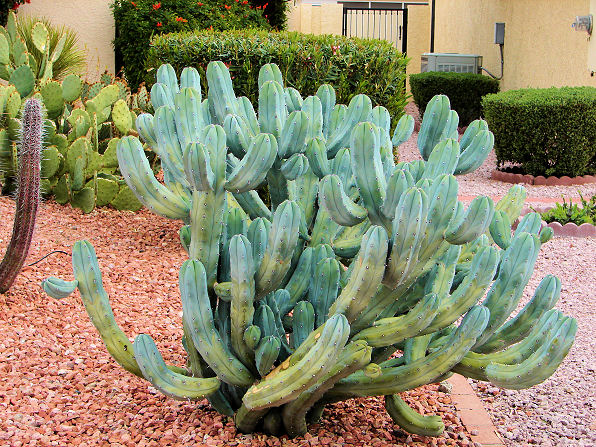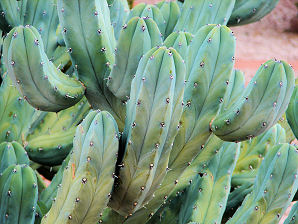Xeriscape Landscaping Plants For The Arizona Desert Environment.
Pictures, Photos, Information, Descriptions,
Images, & Reviews.
Cactus.
Blue Myrtle Cactus, Myrtillocactus geometrizans.
We Are Proud Of Our SafeSurf Rating!
Click On Any Of The Following Links By Amazon.Com
For Books, & Videos About Wildflowers Of Arizona & The Southwest USA. No Obligation!
 |
| Blue Myrtle Cactus, Myrtillocactus geometrizans. Photos Taken At Arrowhead Ranch, Glendale, Arizona. Photo Taken February 2, 2006. |
|---|
 | |
| Blue Myrtle Cactus. Myrtillocactus geometrizans. | Blue Myrtle Cactus. Myrtillocactus geometrizans. |
|---|
 /
/

Blue Myrtle Cactus.
We wish to thank Wikipedia, the free encyclopedia for some of the information on this page. We share images and information with Wikipedia. Myrtillocactus geometrizans is native to central and southern Mexico; including the Federal district and states of Hidalgo, Oaxaca, Puebla, Queretaro, San Luis Potosi, Tamaulipas, Tlaxcala, & Veracruz, where it grows in deciduous tropical woods and xerophilous wood lands, between the 3,281 to 6,562 feet of altitude. Its stems are blueish, columnar, basally branching, slow growing up to 15 feet tall. They are 3 to 4 inches in diameter; with 5 to 10 ribs; the areoles on the bottom part of the stems are woolly, oval, 1/8 to 1/4 inch wide, with one to 15 spines, 1/16 to 1/3 inch long; upper areoles 1/3 to 6/10 inch wide, 20 to 75 spines, about 1 1/4 to 4 inches long. The fruits are globose, about 10-20 mm long, with a color similar to the bilberries, with edible pulp containing 1-2 mm long seeds. For short time, it can tolerate temperatures as low as 24�F, but it is better not to expose it to temperatures lower than 46�F. In Mexico, we have seen the flowers, and fruits eaten boiled or fried, as well as eaten fresh or dried; by the local people. Its stems are blueish, columnar, basally branching, slow growing up to 15 feet tall. They are 3 to 4 inches in diameter; with 5 to 10 ribs; the areoles on the bottom part of the stems are woolly, oval, 1/8 to 1/4 inch wide, with one to 15 spines, 1/16 to 1/3 inch long; upper areoles 1/3 to 6/10 inch wide, 20 to 75 spines, about 1 1/4 to 4 inches long. Very attractive for landscape use. It is also less frost resistant, and should be protected below 25�F It has one inch in diameter green - white flowers in March, which become very sweet, edible, dark red, 1/3 inch in diameter fruits.
Quick Notes:
Height: Height to about 15 feet. Spreading to about 8 feet.
Flowers: Small green - white, up to 1 inches in diameter.
Blooming Time: March - April..
Fruit: Purple, with a red pulp.
Stems: Green stems are stems 3 or 4 inches thick.
Found: Native to central and southern Mexico; including the Federal district and states of Hidalgo, Oaxaca, Puebla, Queretaro, San Luis Potosi, Tamaulipas, Tlaxcala, & Veracruz
Elevation: 0 - 4,800 Feet.
Hardiness:
Soil pH requirements:
Sun Exposure:
Habitat: Lower elevations where water is available. It grows well in sand, sandy loam. It needs good drainage and aeration. Common xeriscape landscape plant in Arizona.
Miscellaneous: Maintenance: Low. Photos Taken At Arrowhead Ranch, Glendale, Arizona. Photo Taken February 2, 2006.
|



We Are Proud Of Our SafeSurf Rating!
Click On Any Of The Following Links By Amazon.Com
For Books, & Videos About Xerioscape Plants Of Arizona & The Southwest USA. No Obligation!
Back To Arizona Xeriscape Landscaping Main Page.
Back To Xeriscape Cactus Page Two.
Back To Arizona Wild Flowers Home Page
Back To DeLange Home Page
© 1966 - Present, Audrey, Eve, & George DeLange
| © 1966 - Present, Audrey, Eve, & George DeLange |


